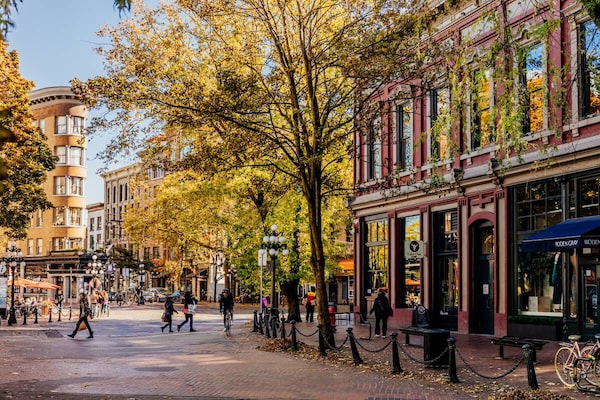
Tourists roam Gastown's brick-paved streetsNelson Mouellic/Destination Vancouver
One afternoon this week I went on a short walk through two worlds.
I began in Gastown. Vancouver had its beginnings here. Tourists roam its brick-paved streets. Locals flock to its pubs and bistros.
It was a warm summer day and the place was bustling. A tour guide led her group past the Hotel Europe, the handsome “flatiron” building. Sleek electric cars sailed by. Couples lined up outside a popular souvlaki bar.
I stopped at a fragrances company that sells little bottles of body lotion for $98 each. I walked into a running-shoe store where Air Jordan 3 “rust pink” sneakers were going for $350. Another pair, covered in Swarovski crystals, glittered in a glass case at the counter. Price: $6,500.
I came out of the store and turned left. Within a minute I was on East Hastings Street, the main avenue of Vancouver’s Downtown Eastside. Canada’s overdose epidemic started here. It rages on still.
No outsider can hope to understand the life of this street. Each individual you pass has a story that brought them here. Along with the pain and conflict, there is kindness, resilience and community. But the pain is visible all around.
This spring, authorities pulled down the jumble of tents that had sprouted on East Hastings. The people of the street remain, roaming its broad sidewalks. Many are burdened by homelessness, mental illness or addictions, often all three at once.
I walked west toward Main Street. I saw a young man and woman, half clothed, slumped against each other with a plastic hookah resting between them. I saw several people drawing on drug pipes. I saw several more sprawled passed-out on the pavement. This went on for block after block.
Many people were using wheelchairs, canes, walkers or mobility scooters. One guy, dressed in a dirty black hoodie and sagging pants, walked with a heavy list, his body leaning to the left from some unknown injury as he struggled down the street, muttering incomprehensibly to himself.
Others sat in clusters on the sidewalk, surrounded by pizza boxes, broken-down bikes, carts piled with their stuff, and drug paraphernalia, the day-to-day necessities of street life. The smell of urine filtered up from the pavement.
Still others stood bent almost in half, their arms and upper bodies hanging down from the waist, a common posture among those under the influence of powerful street drugs.
It has been like this on East Hastings for years and years. The sights you see here are now so familiar that they are just a fact of life, as much a part of the city as the towering trees of Stanley Park or the highrises of the West End.
B.C. announces 330 new homes for Vancouver’s Downtown Eastside homeless
Though a whole host of caring workers in clinics, drop-ins, addiction programs and supervised drug-consumption sites work to keep people on the street alive, they continue to die in staggering numbers. British Columbia just had its worst first seven months of the year on record for fatal overdoses. An average of six people are dying every day, and that doesn’t include those who succumb from the beatings, infections and simple exposure that are part of street life.
A succession of police chiefs, mayors and premiers have grappled with the problem, pouring many millions into fixing it. Only this summer, residents started moving into new supportive housing projects designed to give people a bridge between the street and more permanent homes. The gap between the two worlds seems only to widen. No visitor can travel between them without coming away deeply shocked.
As I walked I wondered: How have we allowed it to happen? How can we continue to accept such suffering in a city of million-dollar houses and $100,000 sports cars? Extremes of wealth and poverty have been a feature of big cities for centuries, but in the Vancouver of the 2020s, they have reached a new level, assaulting our comfortable conception of Canada as a fair and orderly nation.
The two worlds I walked through exist side by side in one of the planet’s most desirable cities. One world is a place of wealth, health and comfort, the other of poverty, illness and hardship.
A mere city block separates them, maybe 200 steps. Yet the gulf between them is as wide as the galaxy. Though you can witness sights of similar distress in Victoria, Toronto or Halifax, no Canadian city has anything on this scale. Nowhere in Canada – nowhere I have seen anywhere – is the contrast between the privileged and the deprived so stark.
After walking along one side of Hastings, I turned around and walked back along the other, passing more gaunt faces, more broken bodies, more stained sidewalks.
Soon I found myself in Gastown again. Young Chinese and Japanese visitors took selfies and browsed in stores. A good-looking couple on brightly painted bikes pedalled by, carrying lawn chairs for a picnic.
I went into a boutique that offered incense from a Japanese island and thousand-dollar high heels from Paris. I paid $4.50 for mineral water bottled in England “by appointment to Her Majesty the Queen.”
I had passed through the invisible wall that divides money from misery. The scenes just around the corner on East Hastings Street seemed light years away – in another world.
 Marcus Gee
Marcus Gee